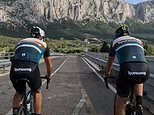
Eat well, exercise daily, and mix with positive people. That’s the standard advice for those who want to live longer, and if you add some banned-in-the-EU pecorino cheese, it’s also the recipe for the Chef’s cycling tour, a one-week cycling and feasting trip into Sardinia’s ‘Blue Zone’ by Italian travel firm Tourissimo.
More about that dangerous cheese shortly, but first, about that Blue Zone. This is a mountainous region with a very high concentration of centenarians, those folks living to 100 and beyond. Centenarians such as Julio.
Julio had a shepherd’s diet of fresh fruit, hard bread, and Sardinian red wine and was still cycling daily at the age of 104.
Julio is no longer with us, but his tales live on during this foodie cycling trip.
Over long lunches on healthful bike rides into the Blue Zone Tourissimo guide Renato Matta would talk of Julio.
Carlton Reid saddled up for Tourissimo’s Chef’s Bike Tour of Sardinia. Above is a still from Carlton’s video of the trip
‘He died in 2020 at the age of one hundred and five years old, so not that bad,’ explained Renato.
‘Julio often complained about his son,’ continued Renato, ‘saying he was lazy; he was wasting his life watching TV all day, sitting on the couch, doing nothing. I asked, “How old is your son, Julio?” He is 80, he replied!’
Sardinia’s Blue Zone is one of only five such zones worldwide; zones where people live longer than average.
The mountainous regions of Ogliastra and Barbagia in the Sardinian province of Nuoro comprise the first such zone to be labelled.
The term was coined by the demographer Michel Poulain and the physician Gianni Pes writing in an old age studies magazine in 2004. Centred on the village of Villagrande Strisaili in the region of Ogliastra, this first Blue Zone shares with the Japanese island of Okinawa the highest rate of centenarians in the world. There are also Blue Zones in Costa Rica and the Greek island of Ikaria.
The village of Villagrande Strisaili in Sardinia is in a ‘Blue Zone’. It’s a term that Carlton learns more about on his trip, discovering that it’s an area where people live longer than average
Geneticists, biologists, dieticians, and all sorts of other researchers dote on such Blue Zones because not only do the locals live long lives, but robust ones, too.
‘Julio was very healthy until the end,’ stressed Renato. ‘No glasses; all his teeth in place.’
Studies say that regular cycling puts ten years on your life, so this cycling holiday in Sardinia will have done me a world of good.
And I needed to burn off the calories because we were extremely well fed, partly because we travelled with our own chef, hence the trip’s name. That chef was Mary Sue Milliken.
According to Wikipedia, Mary Sue is an American restauranteur, cookbook author, and radio and TV personality. What’s not in Wikipedia is that she is also a strong cyclist, on this trip opting to cycle alongside us on a carbon road bike rather than the offered electric flat-bar bike. She cooked for us a couple of times on the tour. And she also decorated our tables with wildflowers picked from the roadside.
Diet is one of the factors behind the longevity of Sardinia’s population. A popular local delicacy, Carlton discovers, is casu marzu pecorino cheese, described as ‘the world’s most dangerous’ because it’s riddled with live maggots. Their poop helps to create a soft creamy texture
Carlton bites into a slice of ‘the world’s most dangerous cheese’
‘Every day I pick a different colour,’ she told me as we panted up a hill.
‘Yesterday was purple. Today I’m deciding between white and pink.’
She was also deciding what to cook for us that night, using the region’s paper-thin flatbread called pane carasau.
‘They also call it carta de musica because you can read a piece of sheet music through the thin dough,’ said Mary Sue.
‘I could make a lasagna with that.’
Mary Sue was also very much along for the trip’s experiential side, which included cookery lessons with local experts.
One night our small group — eleven of us, plus guides, one of them driving a van for any cycling stragglers — tried our hand at making filendeu. This ‘thread of God’ is a very thin pasta that only a handful of Sardinian ‘pasta grannies’ still know how to make. It involves elongating strands from a dough ball until thin enough to lace into a lattice before baking. My fat fingers could only produce unholy blobs.
A drone view of the main road above the Nuraghe Santa Cristina, a village ruin in Sardinia that dates back to the Bronze Age
Our travelling chef’s strands were godlier than mine but still fell short.
‘She makes it look so easy,’ Mary Sue said of our local expert, ‘mine just break.’
Game for most culinary challenges Mary Sue wasn’t so keen on trying the local delicacy I mentioned at the top of this article. Casu marzu is a badass pecorino that Guinness World Records says is the ‘world’s most dangerous cheese’. How so? It’s riddled with live maggots, and thanks to a probably very sensible EU dictat, it can’t be sold in shops.
Back in the day, mountain shepherds had to eat some pretty ripe old stuff.
‘Look, there are lots of worms inside,’ cheered Andrea, a local hotelier, inviting us to chomp down on the for-personal-consumption-only cheese he’d made for guests. More specifically, we would have to chomp down on the wriggling maggots because you don’t want any to be alive as you swallow them.
A ‘pasta granny’ shows Carlton’s group how to make filendeu ‘thread of God’ pasta at Hotel su Gologone, one of the boutique hotels on Tourissimo’s Chef’s Bike Tour of Sardinia
Sardinian for ‘rotting cheese’, casu marzu is fermented by the larvae of Piophila casei flies. After the larvae hatch, their poop breaks down the cheese’s fats and proteins, creating a soft, creamy texture, not the norm for pecorino.
I spread my worm-poop cheese on pane carasau, using a knife to smush anything that wriggled. I also gave the morsel a few extra chews for good measure, not wishing for any grub resurrection party.
Maggot smushing aside, this under-the-counter pecorino was surprisingly delicious. And what’s good for centenarians has got to be good for me.
We were cheese-and-maggot tasting in the cobbled courtyard of an 18th- century townhouse in the mountain village of Villasanto. Our cycling group had been joined by a dance ensemble in traditional dress, and after they and we had danced awhile, we ate together. Only one or two older locals joined the brave few of us cyclists eating the maggot-infested cheese. The younger locals looked on, horrified at one of the dietary secrets that kept their elders fit and healthy into old age.
Tables groaned with other types of cheese as well as bean dishes and slow-cooked meat medleys, including trattallia, a mix of goat’s hearts, liver and lungs wrapped in offal. There was also plenty of wine made from the island’s white Vermentino and red Cannonau grapes. Cannonau is particularly wholesome: it has two to three times the levels of artery-scrubbing flavonoids than other wines. Sardinians drink a little wine every day.
Also in plentiful supply was the Sardinian toast, ‘A chent’annos!’, meaning, ‘May you live a hundred years!’
‘Like your healthy food and wine, but also want to work it off? This could be the trip for you,’ writes Carlton
With that Sardinian version of ‘cheers’ ringing in our ears we left the courtyard, brushing against the island’s macchia, a Mediterranean scrub dotted with aromatic trees and plants such as holm oaks, olive trees, sage, rosemary, and thyme.
Travelling here in the 1920s, English writer D. H. Lawrence dismissed the island as ‘rather bare, rather stark, rather cold and yellow’.
In his travelogue, the Lady Chatterley’s Lover author sniffed that ‘Sardinia is another thing’.
But he was in awe of Sardinia’s ‘brisk and defiant’ common folk — ‘peasants’, he called them — although he didn’t mention their longevity.
He did, however, recognise they were different from Italians on the mainland, a fact that geneticists have since confirmed.
As well as benefitting from daily exercise, good food, and strong communal and religious ties, Sardinians might also live longer because of their ancestors.
Four thousand years ago, the Bronze Age Nuragic people thrived on the island’s fertile coastal plains — building thousands of evocative towers that still dot Sardinia — but they retreated deeper and deeper into the highlands when the Phoenician and Roman empires rose and fell. They developed a wariness of foreigners in the mountains, keeping themselves to themselves.
Native Sardinians became genetic incubators, amplifying certain physical traits over generations. Today, roughly 80 per cent of the locals are directly related to the first Sardinians.
Carlton’s tour group gathers for one of many amazing meals
We didn’t meet any centenarians on our seven-day trip, but at one lusty meal, we were treated to a lecture by Spanish dietitian Anna Maria Canelada, who studied Sardinian centenarians for her PhD.
She explained how new mountain roads built in the 1960s and 1970s – some of which we had ridden on — were responsible for bringing mainland-style foods to those who lived in the hill villages. Good for variety – bad for health. There won’t be many future centenarians from this region because the Blue Zone Sardinians are now eating the same processed foods as the rest of us, and — thanks to the use of cars on those roads — also not exercising as much.
The centenarians that once wowed researchers are a dying breed.
Sobering. And a good reason to keep pedalling.
Dream trip: A bedroom at boutique-y Hotel su Gologone
Each day we would ride up to about 50 miles, with numerous foodie stops including feasting at a shepherd’s hut where we helped drain and shape some ricotta cheese.
At the end of the week, I asked one of the American guests for his thoughts. Michael DiMaggio — yes, he’s related to the baseball icon — said he especially enjoyed arriving in small, hilltop villages, but his abiding memory would be the copious amounts of food.
‘We ate a lot,’ he said. ‘The food kept coming.’
Like your healthy food and wine, but also want to work it off? This could be the trip for you.
Carlton can be found tweeting at @carltonreid and his videos can be found at www.youtube.com/@cyclingnews. Carlton’s footage of the trip can be viewed on YouTube here.
TRAVEL FACTS
The Tourissimo Chef’s Bike Tour of Sardinia is a seven-night trip that costs a touch under £4,500 per person, staying in boutique hotels with all food, wine and education included. Flights extra.
Tourissimo also offers foodie cycling tours in other parts of Italy, including Emilia Romagna, home to the twin gastronomy capitals of Parma and Bologna.
Carlton travelled to Sardinia flight-free, starting with the DFDS ferry from Newcastle to Ijmuiden, near Amsterdam.
After a day in Amsterdam, he took an evening sleeper train to Innsbruck then a high-speed train to Rome and ferry from Civitavecchia, near Rome, to Olbia, Sardinia.
For the rail parts of the trip Carlton benefitted from reduced-cost train travel with an Interrail pass. Launched in March 1972, the Interrail pass was originally for young travellers only, enabling those of up to 21 years of age to explore 21 countries by train with just one rail pass. Since 1998 the Interrail pass has been available for travellers of all ages.
Source link
CHECK OUT: Top Travel Destinations
READ MORE: Travel News



